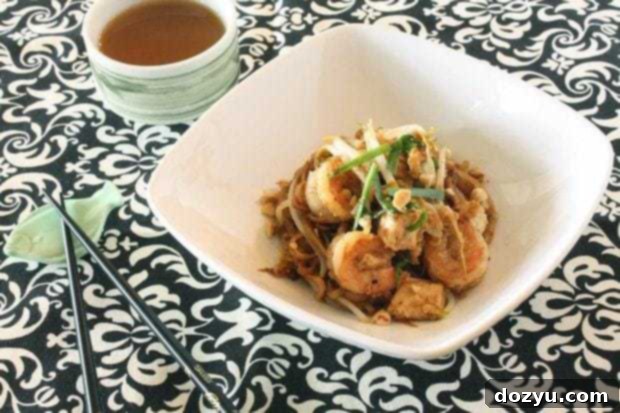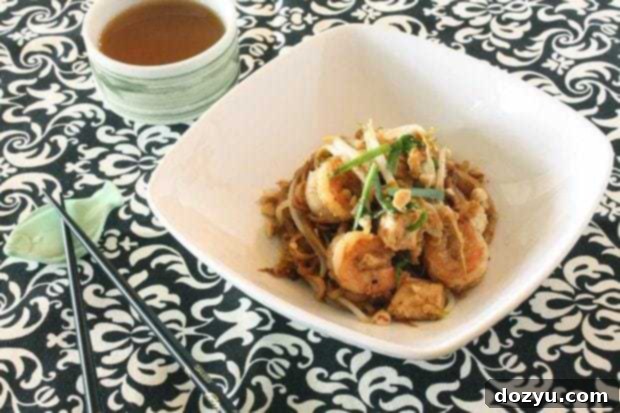Mastering Authentic Pad Thai: A Flavorful Journey to Thailand’s Iconic Noodle Dish
Embarking on the culinary adventure of making authentic Pad Thai at home can be a truly rewarding experience, though I’ll confess, my first few attempts were quite the learning curve! For someone who wasn’t deeply familiar with the nuances of this classic Thai dish, unlike my husband who considers it his absolute favorite food in the world, it required a genuine dive into research and practice. My initial foray into the world of homemade Pad Thai began with a quest to understand what makes a truly great version. I discovered a fantastic Thai restaurant in Denver renowned for its Pad Thai, a place so good that even my discerning husband approved. This tasting served as my benchmark, a delicious starting point before I dared to craft my own version in the kitchen.
The Journey to Authentic Pad Thai: From Chewy Noodles to Culinary Confidence
Making Pad Thai, in my honest opinion, certainly demands a bit of practice. My very first attempt, lacking proper preparation and understanding, turned out to be a bit of a culinary disaster. The noodles, in particular, were unforgivably chewy. I can now confidently say that I’ve unlocked the secrets to perfectly working with rice noodles, but back then, it was a mystery! Thankfully, my second attempt was significantly smoother. With a better grasp of the ingredients, a clearer memory of the preparation process, and a more organized approach, I was able to transform my initial struggles into a much more successful and enjoyable cooking experience. This progression from frustration to familiarity is a common path for many home cooks tackling complex dishes, and Pad Thai is no exception.
Unlocking the Secrets: Preparation is Key
Let me be transparent: Pad Thai becomes surprisingly easy to make *once all your ingredients are meticulously prepared*. This crucial step, often referred to as “mise en place” in professional kitchens, is paramount for stir-fries where cooking happens rapidly at high heat. Two particular elements initially tripped me up: creating the tamarind purée and handling the rice noodles. Crafting the tamarind purée from a block proved to be more involved than I anticipated, eventually requiring the use of a fine-mesh sieve to achieve the desired smooth consistency after my hands-only approach proved fruitless. As for the rice noodles, I made the mistake of using the wrong size and, consequently, didn’t soak them long enough. No amount of stir-frying could salvage them once they were destined to be hard. But once these hurdles are understood and overcome, the actual cooking part is incredibly fast-paced. You’ll find yourself wondering, “Wait, was that it? Really?” as you gaze at your beautifully finished dish.
The magic of Pad Thai lies in its vibrant and balanced flavor profile: a symphony of sweet, sour, salty, and spicy notes, often with a hint of umami. Achieving this balance requires attention to detail and good quality ingredients. It’s not just a dish; it’s a staple of Thai cuisine, embodying the country’s culinary philosophy of harmonizing diverse tastes and textures.
Mastering the Ingredients: What You’ll Need
If you’re truly committed to making authentic Pad Thai from scratch, I cannot recommend enough the invaluable resource over at SheSimmers. This comprehensive guide, a recommendation from Sherri, is the most detailed tutorial I’ve ever encountered. It breaks down the complexities into five manageable parts, ensuring you understand every facet of the dish:
- Part One: The Pan
- Part Two: The Noodles
- Part Three: Notable Ingredients
- Part Four: Sauce and Seasonings
- Part Five: The Recipe
Below, I’ve outlined a recipe inspired by SheSimmers, incorporating a few of my own adjustments and insights gained from experience. **A critical note**: many of these specialized ingredients, especially for the authentic sauce, will need to be sourced from your local Asian market. For those of you residing in Denver, I found my essentials at the market located on the corner of Alameda and Federal.
Understanding each ingredient’s role is key to a successful Pad Thai:
- Rice Noodles: The 2-3mm wide flat rice noodles are essential. Their texture, when properly rehydrated, is what defines Pad Thai. Soaking them in room temperature water for 20-30 minutes allows them to become pliable without turning mushy, ready to absorb the sauce in the pan. Avoid hot water, which can start cooking them too soon.
- Tamarind: This fruit provides the signature sour tang to Pad Thai. Using a block of tamarind for pulp ensures the freshest, most authentic flavor, but requires a simple process of soaking and straining. Pre-made tamarind concentrate can be used as a shortcut, but be mindful of its intensity.
- Fish Sauce: The umami backbone of Thai cuisine. A good quality fish sauce adds depth and savory saltiness that cannot be replicated.
- Palm Sugar: Unlike granulated white sugar, palm sugar offers a nuanced, caramel-like sweetness that is integral to the authentic Pad Thai flavor profile. Finely chopping it helps it dissolve more easily in the sauce.
- Shrimp Paste in Oil: This ingredient adds a unique depth of flavor and richness. A small amount goes a long way in enhancing the overall umami.
- Dried Shrimp: These tiny, intensely flavored crustaceans contribute a concentrated seafood essence, elevating the dish’s complexity. Opt for shell-on if possible for maximum flavor, though you’ll want to give them a quick rinse.
- Firm Tofu: Cubed firm tofu adds texture and protein, absorbing the delicious sauce beautifully. It’s a classic component that provides a satisfying chew.
- Chinese Chives & Bean Sprouts: Added at the very end, these vegetables provide a fresh, crisp contrast to the soft noodles and rich sauce. Their quick cooking preserves their vibrant crunch.
Also, mentally prepare yourself for a bit of multi-tasking during the cooking phase! You’ll be stirring noodles while simultaneously tending to other ingredients in the same pan. Don’t worry, the detailed instructions below will guide you through this dynamic process.
While Pad Thai might not be the simplest dish to conquer on your first attempt, with a bit of dedication and practice, it quickly transforms into an awesome recipe to have confidently tucked away in your culinary repertoire. The satisfaction of creating such a flavorful and balanced dish from scratch is truly unmatched.
So, after learning about the journey and the nuances, do you feel inspired to try making your own authentic Pad Thai?

table of contents
Toggle
Pad Thai
ingredients
- 1/2 cup plain vegetable oil
- 4 oz 2 to 3 millimeters wide dried rice noodles soaked in room temp water for 20 to 30 minutes and drained
- 2/3 cup Pad Thai sauce see recipe below
- 1 Tbsp shrimp paste in oil
- 2 cloves garlic finely chopped
- 1 shallot finely chopped
- 1/4 cup small dried shrimp shell-on
- 3/4 cup firm tofu chopped into bite sized pieces
- 1/2 lb shrimp peeled and deveined
- 2 large eggs cracked into a bowl
- 6-7 stalks of Chinese chives blades cut into 1″ pieces
- 2 cups bean sprouts
- Chopped dry-roasted peanuts dried red pepper flakes, sugar, fresh limes for garnish
- 3/4 cup fish sauce
- 1 1/2 cups palm sugar finely chopped
- 1/4 cup brown sugar
- 14 oz block of tamarind which you will turn into tamarind pulp, you can also buy tamarind pulp but it’s cheaper to make it yourself
instructions
-
Prepare the tamarind pulp by soaking the 14oz tamarind block in an equal amount of lukewarm water (approximately 14oz) for about 20 to 25 minutes. This softens the pulp. Then, push the softened tamarind through a fine-mesh sieve, using the back of a spoon to extract as much pulp as possible, discarding any leftover veins, membranes, and seeds. The entire block should yield just the right amount of pulp needed for this sauce.
-
For the Pad Thai sauce, combine the freshly prepared tamarind pulp with the fish sauce, finely chopped palm sugar, and brown sugar in a medium saucepan. Cook this mixture over medium heat, stirring occasionally, until all the sugars are completely dissolved and the sauce has a uniform consistency. Once dissolved, remove the sauce from the heat and allow it to cool to room temperature. This sauce can be made in advance and stored.
-
In a medium bowl, gently mix together the cut Chinese chives and bean sprouts. Set this mixture aside, as it will be added at the very end to retain its freshness and crunch.
-
Heat half of the plain vegetable oil in a large skillet or cast iron pan over medium-high heat. Ensure the pan is properly hot before proceeding. Once the oil shimmers, add the drained, soaked rice noodles to the pan, followed immediately by the prepared Pad Thai sauce and the shrimp paste. Stir constantly and vigorously to ensure everything is thoroughly mixed. It’s crucial to keep the noodles moving at all times to prevent them from sticking or burning – this is where your multi-tasking skills begin!
-
After approximately 30 to 40 seconds of constant stirring, the noodles should have softened considerably and absorbed some of the delicious sauce. Push the noodles to one side of the pan, creating an empty space. Add the remaining vegetable oil to this empty side. Into the new oil, add the finely chopped garlic, chopped shallot, small dried shrimp, bite-sized pieces of firm tofu, and the peeled and deveined shrimp.
-
This phase, as SheSimmers aptly describes, is “the critical point of the process.” Your goal is a) to keep the noodles continuously moving to prevent them from burning, b) to cook the fresh shrimp until they are about partially opaque, ensuring they don’t overcook later, and c) to make sure nothing sticks to the bottom of the pan, including any small bits of ingredients. This requires dynamic movement and attentive heat management.
-
When the fresh shrimp have started to turn opaque on both sides, swiftly create a well in the middle of the pan. Crack the two large eggs into this well. Using two spatulas, break and scramble the eggs quickly. Allow them to cook on one side for a moment to set slightly before breaking them into smaller, integrated pieces. Throughout this step, remain vigilant that the noodles and other ingredients on the sides of the pan are not burning.
-
Once the eggs are fully cooked and scrambled, all the other components in the pan should also be perfectly cooked. Remove the pan from the heat immediately. Add in a couple of generous handfuls of the reserved Chinese chive and bean sprout mixture. Give everything a quick, final stir to incorporate the fresh vegetables without overcooking them. Serve your homemade Pad Thai immediately to enjoy it at its best!
-
Garnish each serving generously with chopped dry-roasted peanuts for crunch. For individualized flavor, provide additional dried red pepper flakes for heat, a sprinkle of sugar for sweetness, and fresh lime wedges to squeeze over the dish for a burst of bright acidity. Extra fish sauce can also be offered for those who prefer more savory depth.
